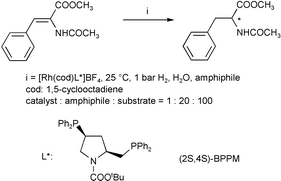Hydrophobically modified water-soluble polymers and polyelectrolytes as micellar promotors in the Rh(i) catalyzed hydrogenation of an amino acid precursor in water
Abstract
Hydrophobically modified water-soluble

* Corresponding authors
a
Institut für Organische Katalyseforschung an der Universität Rostock e.V., Buchbinderstr. 5-6, Rostock, Germany
E-mail:
guenther.oehme@ifok.uni-rostock.de
Fax: +49 381 466 9324
b Fachbereich Physik der Universität Rostock, Universitätsplatz 3, Rostock, Germany
c micromod GmbH, Friedrich-Barnewitz-Str. 4, Rostock, Germany
Hydrophobically modified water-soluble

 Please wait while we load your content...
Something went wrong. Try again?
Please wait while we load your content...
Something went wrong. Try again?
H. Fuhrmann, I. Grassert, G. Holzhüter, C. Grüttner and G. Oehme, New J. Chem., 2002, 26, 1675 DOI: 10.1039/B202992H
To request permission to reproduce material from this article, please go to the Copyright Clearance Center request page.
If you are an author contributing to an RSC publication, you do not need to request permission provided correct acknowledgement is given.
If you are the author of this article, you do not need to request permission to reproduce figures and diagrams provided correct acknowledgement is given. If you want to reproduce the whole article in a third-party publication (excluding your thesis/dissertation for which permission is not required) please go to the Copyright Clearance Center request page.
Read more about how to correctly acknowledge RSC content.
 Fetching data from CrossRef.
Fetching data from CrossRef.
This may take some time to load.
Loading related content
